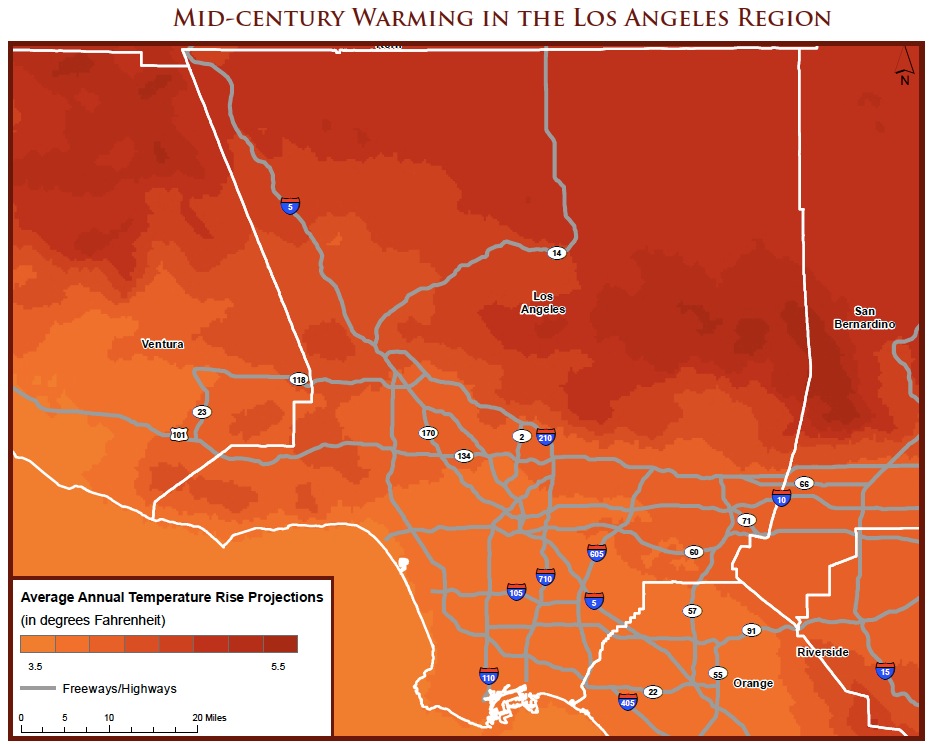ENVIRONMENTAL DEFENSE FUND
UCLA LUSKIN CENTER FOR INNOVATION
Introduction
The Environmental Defense Fund commissioned the UCLA Luskin Center for Innovation to profile the potential for clean energy investments in Los Angeles County. The Los Angeles Solar and Efficiency Report (LASER): An Atlas of Investment Potential is multi-faceted. The LASER Atlas begins with this particular profile of clean energy investment potential at the county level. Other profiles that comprise the LASER Atlas are at the sub-regional level.
Objectives
This county level overview is designed to help community stakeholders identify areas of high potential for solar energy and the benefits of green economic investment. These benefits include capitalizing on incoming state and local funding while creating jobs and building community resilience to current environmental health and energy threats that climate change will exacerbate.
Importance of Project
This project is timely because of new state funding opportunities that could benefit communities throughout Los Angeles County. The maps identify disadvantaged communities that could be prioritized for funding from cap-and-trade auction proceeds (in the Greenhouse Gas Reduction Fund) per Senate Bill 535 (de León). In addition, Proposition 39 will result in $2.5 billion to improve energy efficiency and expand clean energy generation.
A Hotter Region
The map below illustrates “Mid-Century Warming in the Los Angeles Region.” This is the first study to provide specific climate-change projections for the greater Los Angeles area, with unique projections down to the neighborhood level.
The study looked at the years 2041–60 to predict the average temperature change by mid-century. Southern Californians should expect slightly warmer winters and springs but much warmer summers and falls, with more frequent heat waves. The map shows that climate change will cause temperatures in the Los Angeles region to rise by an average of 4-5°F by the middle of this century. 2
All areas across the Los Angeles region will experience warming in the coming mid-century but an important aspect of this study is that it shows where different areas will experience different degrees of warming. According to the study, coastal areas like Santa Monica and Long Beach are likely to warm an average of 3 to 4 degrees, with other areas experiencing more warming. The study predicts a likely tripling in the number of extremely hot days in the downtown area and quadrupling the number in the valleys and at high elevations.
Adapting to a changing climate and building resiliency will be inevitable in the Los Angeles region.
- Higher temperatures will increase the importance of energy efficient buildings. Conservation and improved energy efficiency—with higher performing heating, ventilating and cooling systems, efficient lighting, etc.—will reduce the demand for energy, thus saving money for residents, owners and taxpayers. Producing solar energy on rooftops as well as retrofitting roofs to reflect sunlight (cool roofs), can also reduce electricity bills, while reducing emissions that contribute to climate change.
- Municipal buildings can serve as cooling centers. This will be important because without this and other planning measures in place, hospitals will likely see an increase in patients suffering from heat stroke and heat exhaustion, as well as smog-related respiratory effects. Air quality is profoundly affected by higher temperatures because heat increases ozone smog formation. Ozone is a known lung irritant associated with asthma attacks, pneumonia and other respiratory diseases.
- Green spaces and trees reduce the heat island effect caused by buildings and streets, and provide a place for people to cool off. Transit provides transportation access to parks, medical care and other services that can improve community resiliency to climate change.
Download full version (PDF): Profile of Clean Energy Investment Potential in Los Angeles County
About the Environmental Defense Fund
www.edf.org
Environmental Defense Fund’s mission is to preserve the natural systems on which all life depends. Guided by science and economics, we find practical and lasting solutions to the most serious environmental problems. This has drawn us to areas that span the biosphere: climate, oceans, ecosystems and health. Since these topics are intertwined, our solutions take a multidisciplinary approach.
About the UCLA Luskin Center for Innovation
luskin.ucla.edu
Established with a gift from Meyer and Renee Luskin, the UCLA Luskin Center for Innovation translates world-class research into real-world policy and planning solutions. Organized around initiatives, the Luskin Center addresses pressing issues of energy, transportation and sustainability. The Luskin Center is based in the UCLA Luskin School of Public Affairs.
Tags: CA, California, Environmental Defense Fund, LA, LASER, Los Angeles, Los Angeles Solar and Efficiency Report, Luskin School of Public Affairs, Solar Energy, Transportation Research at the University of California, UCLA, University of California







 RSS Feed
RSS Feed